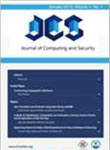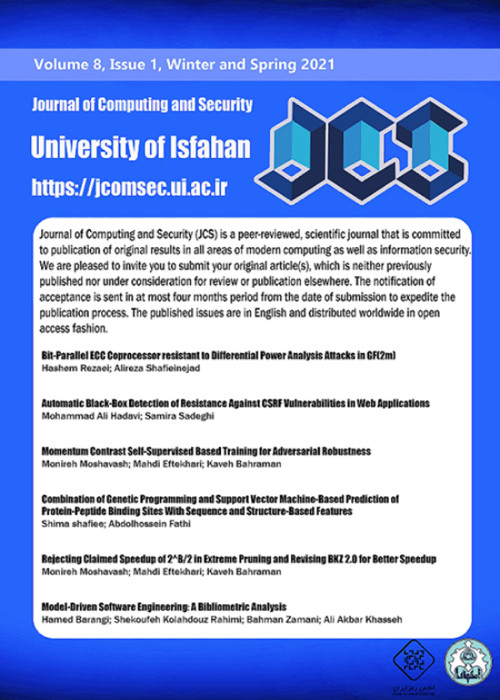فهرست مطالب

Journal of Computing and Security
Volume:3 Issue: 2, Spring 2016
- تاریخ انتشار: 1395/03/20
- تعداد عناوین: 4
-
-
Pages 83-93Although data outsourcing provides many benefits, it suffers from privacy and security concerns such as enforcement of access control policies and confidentiality of stored sensitive data. Current encryption-based security solutions are inflexible in enforcing fine-grained access control policies and it is necessary for data owner to laboriously specify access control permissions per data item. Additionally, the current indexing methods disregard any control on accessing the relevant data and may cause information leakage. This paper proposes a novel indexing technique to enforce access control policies at server side and based on the value of encrypted data. By exploiting this indexing method and selective encryption, we introduce an access control aware indexing technique, which we refer to as Inference Resistant Indexing Technique (IRIT). The proposed technique, not only prevents leakage of information but also overcomes the overheads associated with a separate access control enforcement mechanism. Meanwhile, the overhead associated with updating access control policies is noticeably reduced. The paper provides a simulation of the proposed technique and a comparison with the alternative approaches to assess the performance of the proposed technique.Keywords: Data Outsourcing, Secure Encrypted Data Indexing, Server-side Access Control Enforcement
-
Pages 95-110Network traffic identification is an essential component for effective network analysis and management. Signature-based and machine learning techniques are the two most important methods in network traffic analysis. Due to the strengths and weaknesses of these two approaches, their combination can strengthen them and remove the weaknesses of each in detection process. In this article, a hybrid method is introduced, to identify major network tunneling protocols. This method can detect the well-known tunneling protocols by combining signature-based methods and statistical analysis techniques through a clustering algorithm. In this proposed method, the clustering process is refined by the feedback of signature-base method. Since, in semi-supervised clustering, it is important to gain most informative data to improve the clustering performance, in the proposed clustering method, a new active learning approach is introduced for selecting informative constraints. In this hybrid method, four tunneling protocols (L2TP, PPTP, IPsec and OpenVPN) are applied. The obtained results indicate that this proposed hybrid method significantly increases accuracy and cluster purity, and these protocols are identified with high accuracy and low processing cost.Keywords: Traffic Detection, Tunneling Protocols, Packet Payload Analysis, Semi-Supervised Clustering, Active Learning
-
Pages 111-125In this paper, the binary gravitational search algorithm and support vector machines have been used to diagnose epilepsy. At first, features are extracted from EEG signals by using wavelet transform and fast fractional Fourier transform. Then, the binary gravitational search algorithm is used to perform feature selection, instance selection and parameters optimization of support vector machines, and finally constructed models are used to classify normal subjects and epilepsy patients. The appropriate choice of instances, features and classifier parameters; considerably affects the recognition results. In addition, the dimension reduction of the features and instances is important in terms of required space to store data and required time to execute the classification algorithms. Feature selection, instance selection and parameters optimization of support vector machines have been implemented both simultaneously and stepwise. The performance metrics in this study are accuracy, sensitivity, specificity, number of selected features, number of selected instances and execution time. The results of experiments indicate that the simultaneous implementation of feature selection, instance selection and support vector machines parameters optimization leads to better results in terms of execution time in comparison with the stepwise implementation. In the stepwise implementation, performing instance selection process before feature selection leads to better results in terms of accuracy, sensitivity and specificity, as well as reduction of execution time. The results show that the proposed methods achieve noteworthy accuracy in comparison with other methods that were used to diagnose epilepsy.Keywords: Epilepsy Diagnosis, Gravitational Search Algorithm, Support Vector Machines, Instance Selection, Feature Selection, Parameters Optimization
-
Pages 127-145This paper is an attempt to introduce AUBUE - Adaptive User-Interface Based on User's Emotions- in which user's emotions are detected through the users` interactions with the keyboard; then a graphical user interface's color is adapted in accordance with the user's emotion. The emotions of joy, distress, and anger from the Ortony, Clore, and Collins (OCC) emotion model are utilized to replicate the emotional state of the user. After detection of emotions and their intensities, the current mood of the user is updated, and the appropriate colors for the background of the graphical user interface are chosen with regards to the user's current mood. For evaluation of the AUBUE, we implemented a game for guessing picture name. The game included four elements: (1) logging the demographic information, (2) type speed estimator, (3) guessing picture name, and (4) help. An evaluation was accomplished in two modes: in mode_1, the background color is static, and in mode_2 where the background's color based on user's emotion is dynamic. The results are represented based on the demographic factors and categorized in four groups: English level, English typing level, gaming experience and gender.Keywords: Human-Computer Interaction, Affective Computing, Adaptive Interface, Emotion, Mood, Color Selection


